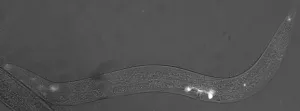(Press-News.org) Using laboratory-grown roundworms as well as human and mouse eye tissue, University of Maryland School of Medicine (UMSOM) researchers have identified a new potential mechanism for age-related macular degeneration--the leading cause of blindness among older adults. The UMSOM researchers say that the findings suggest a new and distinct cause that is different from the previous model of a problematic immune system, showing that the structural organization of the eye's light-detecting cells may be affected by the disease.
The discovery offers the potential to identify new molecular targets to treat the disease. Their discovery was published on April 12 in the Proceedings of the National Academy of Sciences (PNAS).
According to the National Eye Institute, more than 14 percent of Americans over the age of 80 have age-related macular degeneration--a condition that leads to the progressive loss of vision with no known cure. Treatment exists for the "wet" version of the disease affecting only 10% of those with the condition, meaning most have no options.
"In order to find a cure for a disease, you have to fully understand what causes it, and we identified potential new contributors that were not known before," says Bruce Vogel, PhD, Assistant Professor of Physiology and Scientist at the UMSOM's Center for Biomedical Engineering and Technology (BioMET).
Several years ago, researchers had identified genetic mutations in the protein complement factor H as a contributor in large number of macular degeneration cases. Complement factor H marks cells in the body as self and protects them from attack by the immune system, whose job it is to eliminate invading pathogens and cells that do not belong. As a result, due to complement factor H's role in this process, it was thought that macular degeneration was likely due to the immune system attacking its own body's cells that were not marked properly as "self."
According to Dr. Vogel, since identifying effective new therapies for the disease has been slow, he wanted to see if his team could find new insights from studying the disease components in his laboratory model of the roundworm, C. elegans.
Dr. Vogel's team found a worm version of complement factor H protein located in the sensory neurons that help the worms detect chemicals, food, touch, and temperature. The protein appeared specifically in the middle region of the sensory neuron's little antennas, known as cilia (that do the work of sensing the environment), just next to another known important antenna protein called inversin. However, in worms bred to lack complement factor H, they found the inversin spread throughout the antennas rather than remaining in the middle of the antennas.
Next, the researchers confirmed their results in the light-detecting cells in tissue from human retinas. Complement factor H and inversin had the same positioning next to each other in the antenna of light-detecting cells from healthy samples. Yet in people with complement factor H mutations (i.e. people genetically predisposed to macular degeneration), they found the inversin spread around, no longer restricted to its neat banding pattern on the antenna.
"Our findings suggest that complement factor H plays a role in maintaining the organization of photoreceptor cilia and this process may be defective in age-related macular degeneration," says Vogel. "We plan to continue this work to determine how this structural disruption affects vision and to determine whether we can reverse the disruption and restore photoreceptor function."
"Age-related blindness is a vastly untreated condition that will only become more common as our population continues to age," says Albert Reece, MD, PhD, MBA, Executive Vice President for Medical Affairs, University of Maryland Baltimore, and the John Z. and Akiko K. Bowers Distinguished Professor and Dean, University of Maryland School of Medicine. "Studies like these are key to laying the groundwork needed to eventually develop treatments in order to treat blindness keeping older adults living independently and maintaining their quality of life."
INFORMATION:
The research was supported by a grant from the National Eye Institute (R21-EY030188).
The researchers do not report any financial conflicts related to this work.
About the University of Maryland School of Medicine
Now in its third century, the University of Maryland School of Medicine was chartered in 1807 as the first public medical school in the United States. It continues today as one of the fastest growing, top-tier biomedical research enterprises in the world -- with 45 academic departments, centers, institutes, and programs; and a faculty of more than 3,000 physicians, scientists, and allied health professionals, including members of the National Academy of Medicine and the National Academy of Sciences, and a distinguished two-time winner of the Albert E. Lasker Award in Medical Research. With an operating budget of more than $1.2 billion, the School of Medicine works closely in partnership with the University of Maryland Medical Center and Medical System to provide research-intensive, academic and clinically based care for nearly 2 million patients each year. The School of Medicine has more than $563 million in extramural funding, with most of its academic departments highly ranked among all medical schools in the nation in research funding. As one of the seven professional schools that make up the University of Maryland, Baltimore campus, the School of Medicine has a total population of nearly 9,000 faculty and staff, including 2,500 student trainees, residents, and fellows. The combined School of Medicine and Medical System ("University of Maryland Medicine") has an annual budget of nearly $6 billion and an economic impact more than $15 billion on the state and local community. The School of Medicine, which ranks as the 8th highest among public medical schools in research productivity, is an innovator in translational medicine, with 600 active patents and 24 start-up companies. The School of Medicine works locally, nationally, and globally, with research and treatment facilities in 36 countries around the world. Visit medschool.umaryland.edu
PRINCETON, N.J.--Increasing diversity remains a key priority at universities, especially in the wake of mass demonstrations in support of racial equality in 2020 following the death of George Floyd. Many universities are guided by the motivation that diversity enhances student learning, a rationale supported by the U.S. Supreme Court.
This approach, however, is a view preferred by white and not Black Americans, and it also aligns with better relative outcomes for white Americans, according to a paper published by Princeton University researchers in the Proceedings of the National Academy of Sciences.
Across eight studies including 1,200 participants, the researchers looked at two different approaches to diversity: an "instrumental rationale," which asserts that including ...
BOSTON - Many patients with cancer receive immune checkpoint inhibitors that strengthen their immune response against tumor cells. While the medications can be life-saving, they can also cause potentially life-threatening side effects in internal organs. This double-edged sword makes it challenging for clinicians to decide who should be considered candidates for treatment. A new analysis led by researchers at Massachusetts General Hospital (MGH) indicates which patients are at elevated risk of side effects severe enough to require hospitalization. The findings are published in the END ...
BOSTON - Immune checkpoint inhibitors, which boost the immune system's response against tumor cells, have transformed treatment for many advanced cancers, but short-term clinical trials and small observational studies have linked the medications with various side effects, most commonly involving the skin. A more comprehensive, population-level analysis now provides a thorough look at the extent of these side effects and provides insights on which patients may be more likely to experience them. The research was led by investigators at Massachusetts General ...
Abstract #LB008
HOUSTON -- A preclinical study led by researchers at The University of Texas MD Anderson Cancer Center shows an antibody-drug conjugate (ADC) targeting surface protein MT1-MMP can act as a guided missile in eradicating osteosarcoma tumor cells without damaging normal tissues. This technology, using precision therapy targeting of cell-surface proteins through a Bicycle toxin conjugate (BTC), shows encouraging results for the treatment of osteosarcoma.
Findings from the study were presented today by Yifei Wang, M.D., a postdoctoral fellow of Pediatrics Research, at the virtual ...
Blood taken from a small group of children before the COVID-19 pandemic contains memory B cells that bind SARS-CoV-2 and weakly cross-react with other coronaviruses, a new study finds, while adult blood and tissue showed few such cells. "Further study of the role of cross-reactive memory B cell populations... will be important for ongoing improvement of vaccines to SARS-CoV-2, its viral variants, and other pathogens," the authors say. As the COVID-19 pandemic has continued, children have often exhibited faster viral clearance and lower viral antigen loads than adults; whether B cell repertoires against SARS-CoV-2 (and other pathogens) differ between children and ...
WOODS HOLE, Mass. -- Nitrogen is an element basic for life -- plants need it, animals need it, it's in our DNA -- but when there's too much nitrogen in the environment, things can go haywire. On Cape Cod, excess nitrogen in estuaries and salt marshes can lead to algal blooms, fish kills, and degradation of the environment.
In a study published in Environmental Research Letters, scientists at the Marine Biological Laboratory (MBL) Ecosystems Center examine ways to reduce the nitrogen footprint of smaller institutions, like the MBL, by focusing on a bottom-up approach.
"This bottom-up approach is all about balancing the needs of various stakeholders to come up with the best, ...
When winter storms threaten to make travel dangerous, people often turn to salt, spreading it liberally over highways, streets and sidewalks to melt snow and ice. Road salt is an important tool for safety, because many thousands of people die or are injured every year due to weather related accidents. But a new study led by Sujay Kaushal of the University of Maryland warns that introducing salt into the environment--whether it's for de-icing roads, fertilizing farmland or other purposes--releases toxic chemical cocktails that create a serious and growing global threat to our freshwater supply and human health.
Previous studies by Kaushal and his team showed that added salts in the environment can interact with soils and infrastructure to release a cocktail of metals, ...
Researchers have genetically engineered a probiotic yeast to produce beta-carotene in the guts of laboratory mice. The advance demonstrates the utility of work the researchers have done to detail how a suite of genetic engineering tools can be used to modify the yeast.
"There are clear advantages to being able to engineer probiotics so that they produce the desired molecules right where they are needed," says Nathan Crook, corresponding author of the study and an assistant professor of chemical and biomolecular engineering at North Carolina State University. "You're not just delivering drugs or nutrients; you are effectively manufacturing the drugs or nutrients on site."
The study focused ...
Spanking may affect a child's brain development in similar ways to more severe forms of violence, according to a new study led by Harvard researchers.
The research, published recently in the journal Child Development, builds on existing studies that show heightened activity in certain regions of the brains of children who experience abuse in response to threat cues.
The group found that children who had been spanked had a greater neural response in multiple regions of the prefrontal cortex (PFC), including in regions that are part of the salience network. These areas of the brain respond to cues in the environment that tend ...
Energy flows through a system of atoms or molecules by a series of processes such as transfers, emissions, or decay. You can visualize some of these details like passing a ball (the energy) to someone else (another particle), except the pass happens quicker than the blink of an eye, so fast that the details about the exchange are not well understood. Imagine the same exchange happening in a busy room, with others bumping into you and generally complicating and slowing the pass. Then, imagine how much faster the exchange would be if everyone stepped back and created a safe bubble for the pass to happen unhindered.
An international collaboration of scientists, including UConn Professor of Physics Nora Berrah and post-doctoral researcher ...




